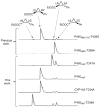Mutating a Highly Conserved Residue in Diverse Cytochrome P450s Facilitates Diastereoselective Olefin Cyclopropanation
- PMID: 26690878
- PMCID: PMC5241096
- DOI: 10.1002/cbic.201500624
Mutating a Highly Conserved Residue in Diverse Cytochrome P450s Facilitates Diastereoselective Olefin Cyclopropanation
Erratum in
-
Corrigendum: Mutating a Highly Conserved Residue in Diverse Cytochrome P450s Facilitates Diastereoselective Olefin Cyclopropanation.Chembiochem. 2016 Nov 3;17(21):2099. doi: 10.1002/cbic.201600528. Epub 2016 Oct 12. Chembiochem. 2016. PMID: 27805325 No abstract available.
Abstract
Cytochrome P450s and other heme-containing proteins have recently been shown to have promiscuous activity for the cyclopropanation of olefins using diazoacetate reagents. Despite the progress made thus far, engineering selective catalysts for all possible stereoisomers for the cyclopropanation reaction remains a considerable challenge. Previous investigations of a model P450 (P450BM3 ) revealed that mutation of a conserved active site threonine (Thr268) to alanine transformed the enzyme into a highly active and selective cyclopropanation catalyst. By incorporating this mutation into a diverse panel of P450 scaffolds, we were able to quickly identify enantioselective catalysts for all possible diastereomers in the model reaction of styrene with ethyl diazoacetate. Some alanine variants exhibited selectivities that were markedly different from the wild-type enzyme, with a few possessing moderate to high diastereoselectivity and enantioselectivities up to 97 % for synthetically challenging cis-cyclopropane diastereomers.
Keywords: biocatalysis; cyclopropanation; cytochromes; protein engineering.
© 2016 WILEY-VCH Verlag GmbH & Co. KGaA, Weinheim.
Figures


References
-
- Arnold FH. Q Rev Biophys. 2015;48:404–410. - PubMed
-
- Alliot J, Gravel E, Pillon F, Buisson DA, Nicolas M, Doris E. Chem Commun. 2012;48:8111–8113. - PubMed
- Chen DYK, Pouwer RH, Richard JA. Chem Soc Rev. 2012;41:4631–4642. - PubMed
- Shuto S, Ono S, Hase Y, Kamiyama N, Takada H, Yamasihita K, Matsuda A. J Org Chem. 1996;61:915–923.
- Wong HNC, Hon MY, Tse CW, Yip YC, Tanko J, Hudlicky T. Chem Rev. 1989;89:165–198.
-
- Morandi B, Carreira EM. Science. 2012;335:1471–1474. - PubMed
- Wolf JR, Hamaker CG, Djukic JP, Kodadek T, Woo LK. J Am Chem Soc. 1995;117:9194–9199.
- Davies HML, Beckwith REJ. Chem Rev. 2003;103:2861–2904. - PubMed
- Doyle MP, Forbes DC. Chem Rev. 1998;98:911–936. - PubMed
- Ho CM, Zhang JL, Zhou CY, Chan OY, Yan JJ, Zhang FY, Huang JS, Che CM. J Am Chem Soc. 2010;132:1886–1894. - PubMed
- Lai TS, Chan FY, So PK, Ma DL, Wong KY, Che CM. Dalton Trans. 2006:4845–4851. - PubMed
- Mazet C, Kohler V, Pfaltz A. Angew Chem Int Ed. 2005;44:4888–4891. - PubMed
- Angew Chem. 2005;117:4966–4969.
- Zhu S, Xu X, Perman JA, Zhang XP. J Am Chem Soc. 2010;132:12796–12799. - PubMed
- Lindsay VNG, Lin W, Charette AB. J Am Chem Soc. 2009;131:16383–16385. - PubMed
-
- Bordeaux M, Tyagi V, Fasan R. Angew Chem Int Ed. 2015;54:1744–1748. - PMC - PubMed
- Angew Chem. 2015;127:1764–1768.
- Coelho PS, Brustad EM, Kannan A, Arnold FH. Science. 2013;339:307–310. - PubMed
- Heel T, McIntosh JA, Dodani SC, Meyerowitz JT, Arnold FH. Chem Bio Chem. 2014;15:2556–2562. - PMC - PubMed
Publication types
MeSH terms
Substances
Grants and funding
LinkOut - more resources
Full Text Sources
Other Literature Sources

